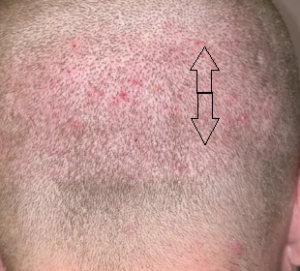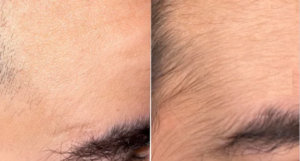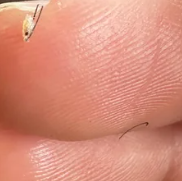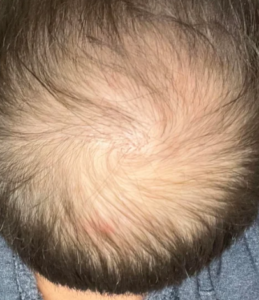I am devastated. Three days ago one of my patients, who had been badly operated on in Turkey, committed suicide. I had seen him in emergency following his bad operation and had proceeded to remove part of the grafts. I saw him again via skype a few days ago and he exclaimed “my savior” …. There was still work to be done and I was enthusiastic about the idea of completing the correction work….
This isn’t the first time I’ve heard about suicide from patients who’ve been badly operated on, especially when it comes to beards. It’s a terrible ordeal for them to have this bad work in their face. I have a terrible grudge against all those who work badly and who shamelessly and remorselessly ruin the future of young men….
I had a long talk with his parents this morning. They explained to me that their son was consumed with remorse at having been taken in by dishonest people. The sad thing is that correction was possible. He was very concerned about the depletion of his donor area. And he asked me to bring as many grafts as possible to the scalp donor area. The first part of his correction went smoothly, with very good healing of the face, but the feeling that he had mortgaged his future was stronger. He left a long, beautiful and dignified letter which I was unable to read, but which comforted his parents. I think it would indeed be good for the ISHRS and for fight to fight to do an in memoriam to give an example of the psychological risk a patient can take by putting himself in non-expert hands.
Dr. Rassman’s comments: In the early to mid 90s, I had three patients that were suicidal as a result of the big plugs that they received for a hair transplant. In those days it wasn’t Illegal Clinics in Turkey, it was American and European doctors that did the deforming surgeries. One young man who committed suicide, Affected me greatly. I Remember talking to his parents before the suicide trying to work with them and comfort him. I offered my services free of charge to fix it. But he couldn’t deal with the stress and prior to the scheduled surgery with me, when he was about to fly out to see me from Ohio, he committed suicide. The family called me to thank me for my efforts. It didn’t make me feel better. The other two got help that I arranged for them. None of these three patients were in California where I practiced. A forth developed Alopecia Areata within a week after his Hair transplant. Dr. Ron Shapiro and I worked with a psychiatrist and prevented the suicide arranging 24/7 care for him after he was properly medicated. He did fine. Bad surgery is not confined to Turkey Black Market Clinics, it happens in our own back yard with poorly trained surgeons offering hair transplants without understanding the fundamentals. Shame on them.
How much density is needed for fine hair to look thick & dense (not transparent) at the hairline? Have you ever seen cases with super fine hair, that achieved good density?
Normal density in a fine-haired individual (like what you had at 15 years of age) was never an Elvis hairline, and you know it. It is impossible to put enough very fine hair to get an Elvis hairline, but you can get the look of what you had when you were 15.
It has been 5-6 weeks now since my hair transplant, no shedding so far. Also started taking fin 1 week after the HT. I can not stop touching my scalp and the new hair. I hope it does not ruin the transplant in some way but I am just super happy. Also since the HT I have a lot dandruff is this normal?
What you are calling dandruff, could be scales from the hair transplant. Touching or scratching your recipient site grafts increases the risk of folliculitis. If you feel you must touch it, wash your hands and touch it with the palm of your hand.
I have walked outside very briefly to do things like get groceries. I’ve also driven places with the sun coming through the car windows and sat in the car with the sun blockers down. Is this enough to have ruined my hair transplant? I’ve noticed one side seems thicker than the other and I’m about 19 days after surgery. I didn’t know the sun exposure issue was something that you’re supposed to avoid so hardcore or for so long (‘m reading anywhere from 3-6 months).
The hair transplant has skin at the top of the graft. This skin, which comes from the back of the head, has been protected by the hair for your entire life. They will get sunburned quickly when they are in the recipient area because they never saw the sun. Protecting these grafts is important. I have seen some men with multiple red dots on the transplanted grafts, reflecting a sunburn to the tops of these grafts. It takes months for these grafts to be able to tolerate the sun. In addition, the UV Light may not be great for healing.
Plan on getting a HT I have an autoimmune disorder called LPP & the top of my head started thinning really bad about a year ago hair falling out in clumps flaky I’ve tried meds and everything there’s not much they can really do . It’s killed my confidence but I’m looking at getting a hair transplant to correct my hairline how many grafts would I need? Its just the top of my head thats needs to be filled in I have a really good donor area and I’ve been thinking about a HT for awhile now if anyone could give advice thanks
Having LLP (Lichen planopilaris) is generally a contraindication for a hair transplant, as the odds are that the disease will kill the grafts.
I start to get bald from top of my head. The other areas are staying strong so far. Although the front headline go up a bir, it is not at a level it concerns me much. On the other hand, I have a very thick beard. It is actually more than I like at this point. I want to use this beard to close the balding spot. I don’t really care if the beard will be a bit curly since I don’t plan to have a very long hair. Do you think this would work? What is your experience after a year or more if you had a similar operation? I would like to know what are the results of people who have similar experiences with me.
Scalp hair is the ideal hair for a hair transplant. Beard hair is only used if you run out of scalp hair from overharvesting. Overharvesting reflects poor planning on your doctor’s part. Beard hair, when used, is never used in the leading edge of the hairline because it looks like beard kinky hair.
i had a HT on my crown area. Last night i rolled much in my sleep and i saw i lost a lot of hair in my crown because of the rubbing against the pillow. Can you still damage the grafts at day 20th?
Use an airline pillow and put a pillow on both sides of you so you sleep on your back. Take a good dose of medication to put yourself to sleep. Keep this up for a week. If this happened at day 20, then there is nothing to worry about as the grafts are fully secure by this time.
I am unsure if you have a Class 6 or 7 pattern balding pattern from the photo you supplied to me. Still, in any event, to set realistic expectations, you need to know the following: (1) donor density, (2) donor hair mass, (3) the capabilities of your surgical team, (4) what your Master Plan is for going forward after the hair transplant (may be more than a single hair transplant). There are many limitations for men with fine hair and low donor densities. YOU need to understand these elements, or you might be disappointed with the results.
You need to know the following: (1) donor density, (2) donor hair mass, and (3) what your Master Plan is for going forward after the hair transplant, as you may lose more hair. There are many limitations for men with fine hair and low donor densities. Blonde men generally require fewer grafts to create more fullness. YOU need to understand these elements, or you might be disappointed with the results. Assuming that you have medium-weight hair, I would imagine that 2000 grafts would likely give you a great result. Because you are 22 years old, your balding pattern is not stable, and that means that the hair transplant could accelerate a more advanced pattern if you jump the gun and do the hair transplant at 22. I would wait until you are 25 or 26.
If you maternal grandfather is “dome” bald and your maternal uncle has the same appearance, but his maternal grandfather is not bald: does that mean such gene was inherited through the Y chromosome? Therefore, will my mother carry that on her X chromosome to me?
There is a 50/50 percent chance that you will get the genes from your mother’s or father’s side of the family. By the age of 26, you might know who you take after. Look through a lot of photos of uncles and grandparents and see if you can identify yourself.
I would be greatly concerned if you went to Turkey for most of the ordinary clinics there. They may fill up your crown with most of your donor hair, so when you lose the frontal hair you presently have (a considerable amount), you may not have hair left to transplant. This is primarily a concern if you are under 25 years of age. See a good doctor and find out what your donor supply is, what your hair thickness is, and what hair loss pattern you may likely develop. Would you go to Turkey for a brain surgery?
Also, many young men can reverse this with medications alone. Finasteride is usually very effective in this type of thinning. Add microneedling, and you might find that you avoided a hair transplant altogether.
I was using topical minoxidil before but my scalp was itching very much so I switched to oral minoxidil but now my body has started to itch.
Itching is a sign of allergy to the drug or the carrier. If you have it with the oral, it is likely an allergy to minoxidil.
Page 30 of 1247






